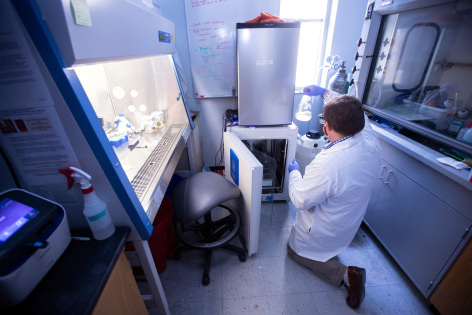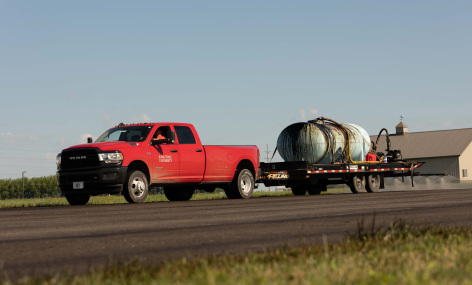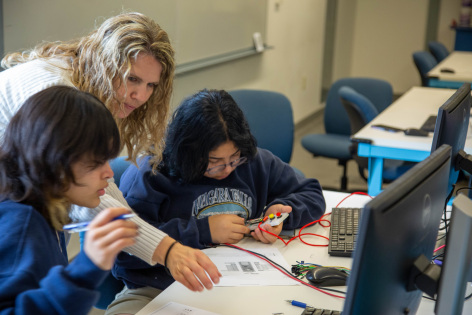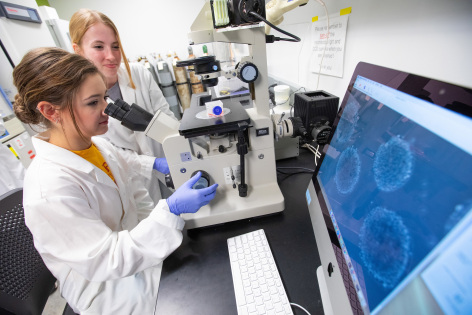
Samuel Rothstein is a member of the startup, Skroot Laboaratory Inc., developing new technologies to assist with the creation of new cancer therapies (Larger image). Christopher Gannon, Iowa State University
AMES, Iowa – An Iowa State University startup that developed a new technology to assist with the creation of new therapies for cancer and autoimmune diseases is just one example of how the university impacts the state's economy and benefits society as a whole.
The value of Iowa State's $5 billion economic impact for fiscal year 2021-22 is measured by its cutting-edge research, economic development support for business and industry, student and visitor spending, alumni earnings, campus operations and construction, and Extension and Outreach. These activities support stronger, more resilient communities, according to an economic impact and investment analysis of Iowa State and other regent institutions conducted for the Iowa Board of Regents.
Iowa State's total economic impact supports 57,142 jobs – or one out of every 36 jobs in Iowa – for fiscal year 2021-2022, the timeframe reviewed for the analysis. Its economic impact in 2021-22 represented 2.4% of the state's gross state product – an impact nearly as large as the entire utilities industry in the state, according to the study.
"Iowa State University supports dynamic economic growth and prosperity through our research, teaching and extension and outreach. We continually adjust our programs to align with the state's workforce demands and the needs of business and industry. By doing so, Iowa State maximizes the return on investment for our students and all Iowans," ISU President Wendy Wintersteen said.
Return on investment
In addition to its economic impact, Iowa State provides a significant return on investment for students and taxpayers. Students earning a bachelor's degree leave Iowa State prepared to enter the workforce, serve as leaders in their communities and will earn $23,600 more each year than someone with a high school diploma working in Iowa.
For taxpayers, the return on funding provided to Iowa State totaled more than $484 million from added tax revenue from students' higher lifetime earnings and increased business output. For every dollar of public money invested in ISU, taxpayers will receive $1.90 in return, over the course of students' working lives.
The following is an overview of key findings from the economic impact analysis and investment analysis. More detail is available in the full report.
Alumni
The education and training Iowa State provides has the greatest impact on the state of Iowa. Today, tens of thousands of alumni employed in Iowa over their career had a net impact of $2.1 billion in added income, which is equivalent to supporting 23,391 jobs.
Research

SoyLei's soybean-based technology is applied to a paving project at the Farm Progress Show near Boone to increase the durability of the asphalt pavement (Larger image). Photo courtesy of Joclyn Bushman/Iowa Soybean Association
SoyLei Innovations – a green technology startup that developed a soybean oil-based alternative to petroleum-based asphalt – is another example of the value of Iowa State research. University research spending and activities created a net total of $235.3 million in added income for the state economy, according to the analysis. The added income is equivalent to 3,822 jobs.
"Innovation and entrepreneurship are critical drivers of the state's economy," Vice President for Research Peter Dorhout said. "Our relentless commitment to creative discovery and invention in research is reflected in startup ventures like SoyLei Technologies. It is this same commitment that makes Iowa State a trusted partner in the development of innovative solutions for federal and state agencies, foundations, and private industry."
Iowa State's Office of Innovation Commercialization works closely with faculty to apply their research and bring it to the marketplace. Over the last four years, Iowa State received 645 invention disclosures, filed 182 new patent applications and produced 174 licenses.
Economic development
Iowa State-supported startup and spinoff companies added $1.7 billion in income to the state economy in fiscal year 2021-22. This impact, which is equivalent to supporting 11,178 jobs, includes the positive effect of ISU's Small Business Development Center and businesses assisted through the Center for Industrial Research and Service (CIRAS).
Extension and Outreach

Nichol Kleespies, 4-H Youth Program Specialist, works with Storm Lake High School students, Saby Ramos and Sofia Almendarez, during a computer engineering workshop as part of an interdisciplinary summer STEM series (Larger image). Photo courtesy of ISU Extension and Outreach
ISU Extension and Outreach provided more than 800,000 direct educational contacts, which includes a food safety certification required by state law. In 2021, more than 2,000 food service supervisors participated in ServSafe classes delivered by ISU human sciences extension and outreach specialists, with 77% earning certification to help ensure food service workers have the knowledge they need to protect the public from foodborne illness.
For 2021-22, Extension and Outreach provided certification for:
- 2,756 companies
- 16,785 farmers
- 21,151 non-farm employees
While employee salaries were included in the analysis, it did not measure the economic impact of Extension and Outreach outcomes due to the specific nature of the majority of programs and services it provides. For example, 4-H is a statewide program that prepares students for STEM fields and leadership roles, but it is difficult to quantify an economic value. Still, the report noted that the private and public value of Extension and Outreach is significant.
Student benefit

Students assisting with a research project at the Nanovaccine Institute (Larger image).
An Iowa State education offers students hands-on learning in the classroom, undergraduate research experiences and countless leadership opportunities. Students earning a bachelor's degree can expect to make $23,600 more each year compared to someone with only a high school diploma in Iowa.
In return for their investment, a student earning a bachelor's degree in 2021-22 will see $1.1 million in higher earnings over the course of their working lifetime. The total present value for all fiscal year 2021-22 students during their working careers is $2.8 billion.
As detailed in the investment analysis, for every dollar Iowa State students invest in the form of out-of-pocket expenses and forgone time and money (while earning their degree), they will receive a cumulative value of $5.10 in higher future earnings. The students' investment has an average annual internal rate of return of 14.6%. The U.S. stock market's 30-year average rate of return of 10.5%.
Taxpayer and societal benefits
Not only do Iowa taxpayers benefit from greater tax revenues from students earning an Iowa State degree, but they also see significant cost savings in three categories: healthcare, justice system and income assistance. Combined, the present value of the benefits associated with an education from Iowa State is nearly $564 million in savings and added taxes for state and local taxpayers.
Through education, research and Extension and Outreach, Iowa State provides nearly $6 billion in benefits to society as a whole. This includes:
- $2.9 billion – added student income
- $1.6 billion – added business income
- $1.1 billion – added income from university activities
- $227.2 million – social savings (related to health, justice system and income assistance)






